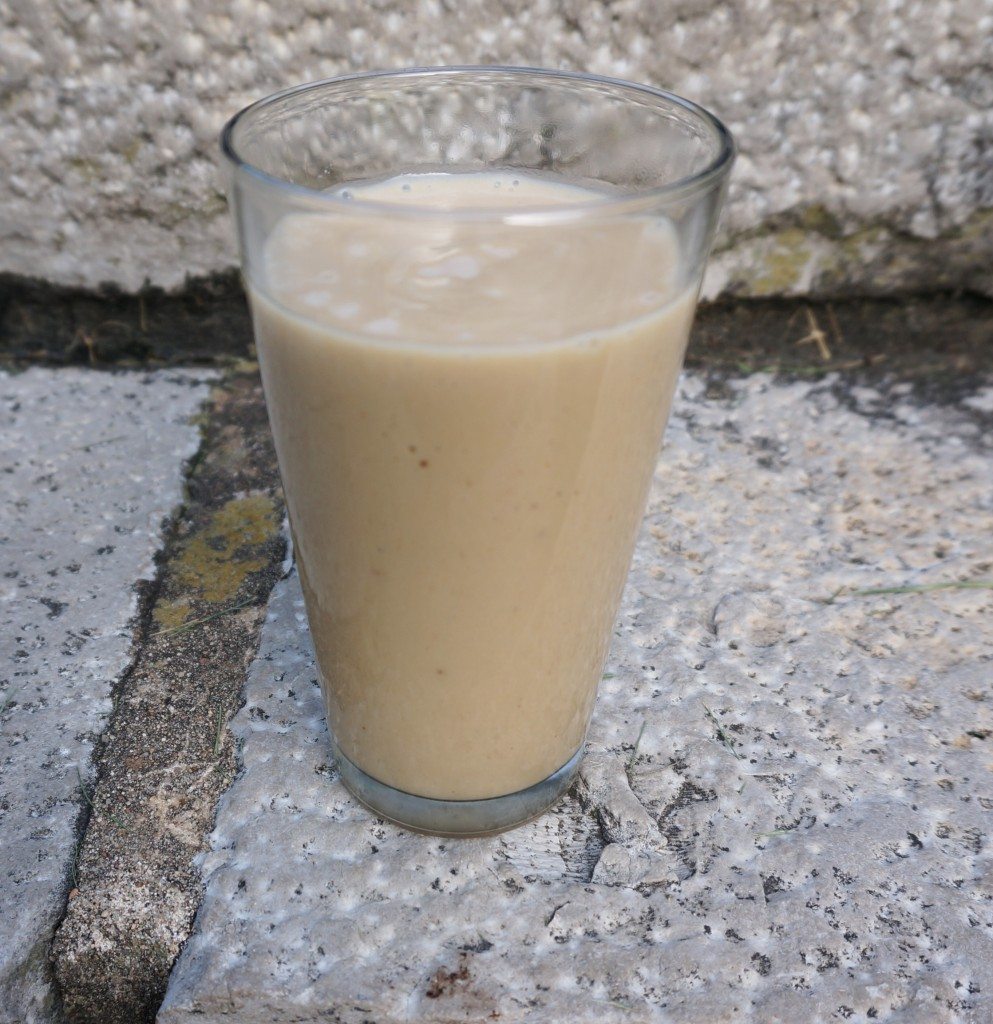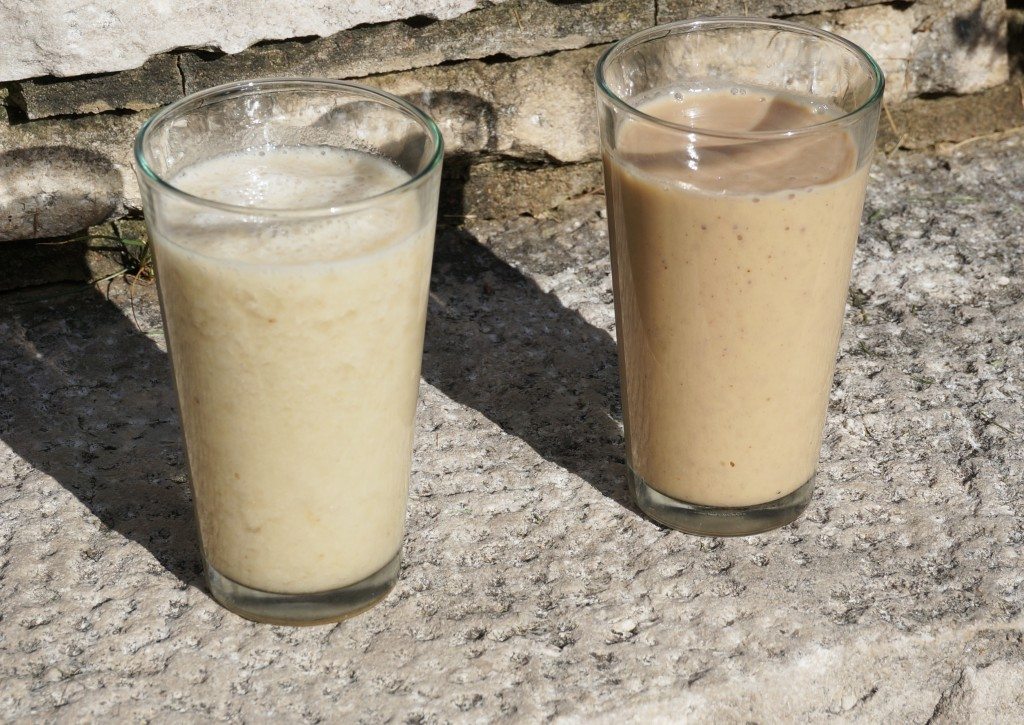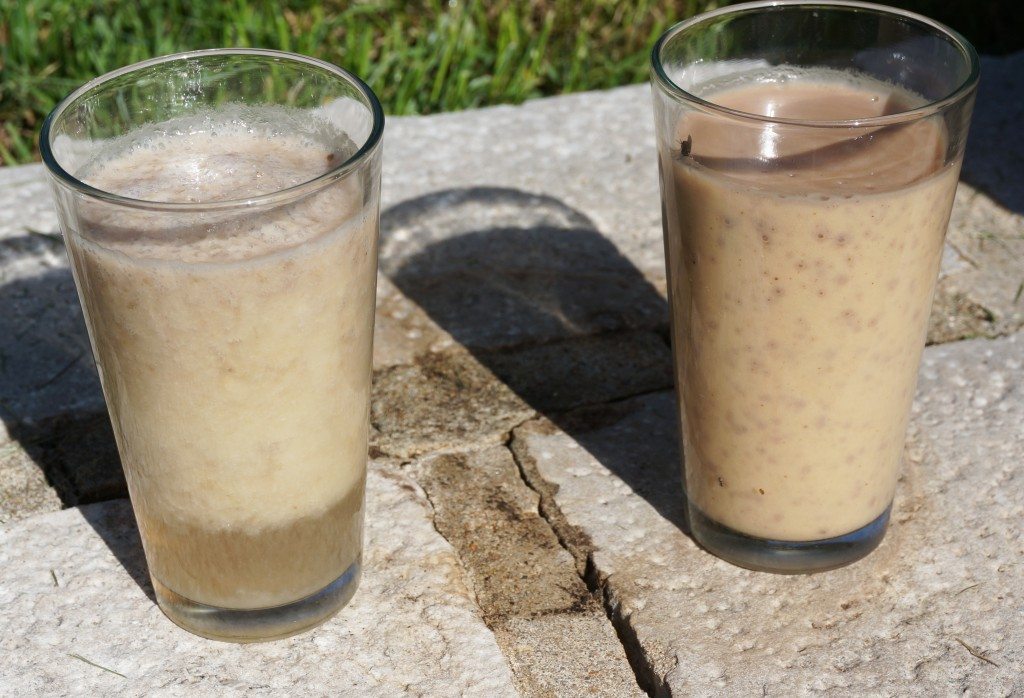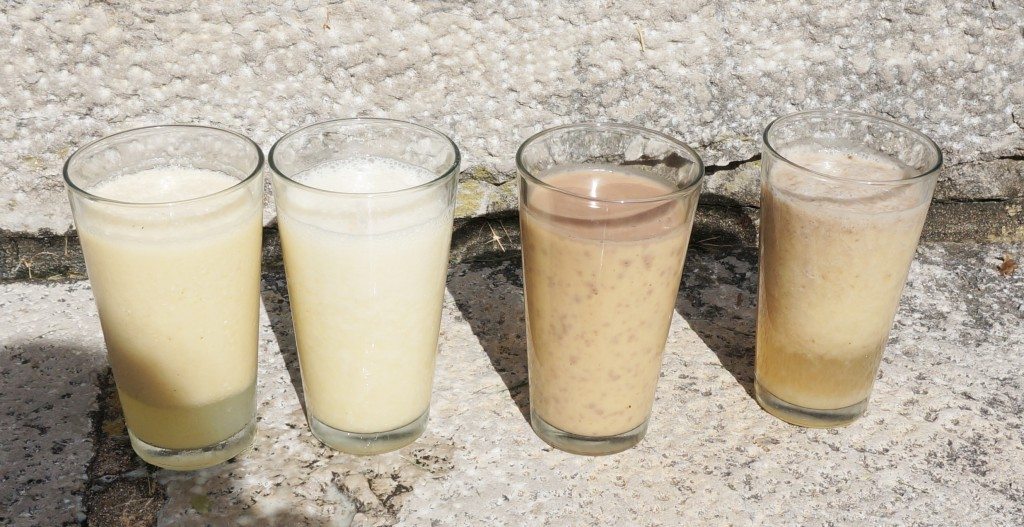July 27, 2015
Last week, I released the podcast episode with Dr. Richard Aiken entitled “How Blenders Can Destroy Food, Why I Eat 20-25 Servings Of Vegetables Each Day, The Vegan-Paleo Debate & Much More“.
During the show, Dr. Aiken explained the potentially damaging effects of high-speed blending on food and referenced a recent experiment he performed on bananas.
Today, Dr. Aiken was kind enough to send me the complete results of that experiment, published in their full, scientifically nerdy details below. Enjoy, and leave your questions, comments and feedback below!
—————————————-
How High Speed Blenders Affect Your Food
There has been some concern as to the effect of high-speed mechanical blending on the nutrient value of fruits and vegetables. The main concern is that rupture of the cell walls and organelles within the plant cell releases nutrients, but also vigorously exposes them to atmospheric oxygen with potentially damaging or nutrient deactivating oxidation reactions.
Before jumping into the experiment that I conducted to determine whether this oxidation actually takes place, it's important to understand exactly how most popular high-speed mechanical blenders work.
There are two primary physical processes that work to mechanically break down the cell wall of plants:
1) shear forces
2) cavitation
Shear forces are created by the high-speed impact of the food with the blender blades. This includes direct cutting by the blade itself as well as shearing by application of high kinetic energy of the particulate matter moving through surrounding medium and striking other particles and the container.
Cavitation is caused by the Bernoulli effect – the same principle behind air flight – planes and helicopters and why boats can sail faster against the wind than with the wind. The speed of the blades in fluid cause a decrease in pressure above the blades equal to the vapor pressure of the fluid, similar to boiling. Bubbles form on the blades (assuming a fluid component), are flung away and implode, causing very powerful shockwaves that further break down even the smallest of remaining particles.
———————————-
The Importance Of Polyphenoloxidases (PPO)
The enzymes in the class Polyphenoloxidases (PPO) appear to reside in the plastids of all plants and are released when the plastid cell membrane is disrupted. PPO is thought to play an important role in the resistance of plants to microbial and viral infections and to adverse climatic conditions.
Phenolic compounds are responsible for the color of many plants and impart taste and flavor. They are important antioxidants. In the presence of oxygen from air, the enzyme PPO catalyzes the first steps in the biochemical conversion of phenolics to produce quinones, which undergo further polymerization to yield dark, insoluble polymers referred to as melanin.
This is the same melanin that determines darkness of human skin and hair. In plants, melanin forms barriers and has antimicrobial properties that prevent the spread of infection in plant tissues. Note that enzymatic browning is considered desirable for the color and taste of tea, coffee and chocolate.
There are many phenolic (or polyphenolic) compounds in fruits and vegetables. Epidemiological studies and associated meta-analyses strongly suggest that long term consumption of diets rich in plant polyphenols offer protection against development of cancers, cardiovascular diseases, diabetes, osteoporosis and neurodegenerative diseases [1].
Polyphenols can be divided into many different subcategories, such as anthocyans and flavonoids. Flavonoids are formed in plants from the aromatic amino acids phenylalanine and tyrosine. Tyrosine also synthesizes DOPA (3,4-dihydroxyphenethylamine) that forms dopamine.
Many plants synthesize dopamine to varying degrees. The highest concentrations have been observed in bananas, levels of 40 to 50 parts per million by weight.
Acidity, temperature, and chemicals can all affect PPO activity. When it comes to acidity, the optimum pH for PPO activity has been shown to be 7 (dopamine substrate). However, the enzyme displays high activity between pH 6.5–7.5 and the activity rapidly decreases at more acidic pH values [2].
Temperature also affects PPO. Heating at 60 degrees for 30 minutes reduces the enzymatic activity by 50%; heating at 90 degrees C completely destroys the enzyme. The optimum temperature for maximum activity is 30 degrees C (86 degrees F).
Finally, some chemicals affect PPO. It has been shown that complete inhibition of PPO activity is found with as low as 0.8 mM ascorbic acid [3]. Ascorbic acid, also known as vitamin C, acts as an antioxidant because it reduces the initial quinone formed by the enzyme to the original diphenol.
Citric acid also can inhibit PPO activity, although not as strongly as ascorbic acid [4]. Citric acid exists in much greater than trace amounts in a variety of fruits and vegetables, most notably citrus fruits. Lemons and limes have particularly high concentrations of the acid; it can constitute as much as 8% of the dry weight of these fruits. The concentrations of citric acid in citrus fruits range from 0.005 mol/L for oranges and grapefruits to 0.30 mol/L in lemons and limes [5].
———————————
The Banana Blending Experiment
Organic bananas (PLU-94011) at ripening stage 5 (yellow peel with green tip) were used for this study. Dopamine has been reported as the major natural occurring substrate in banana pulp and the fastest and most important reactant in the production of melanin (darkening) [6]. PPO activity was determined by visualization of browning on a scale 0 – 5, where 5 is darkest noted and 0 is no noted darkening.
Direct blending high-speed one minute
The first trial involved blending three bananas directly in a Vitamix blender, first at slower speeds, then when mixed, at high speeds for 60 seconds. A significant vortex formed.
The results are shown below.
Note this picture was taken within 15 seconds of the end of the blending. Already a browning is seen. I will assign a darkness scale of 4 to this, where 5 is the darkest of any of the trials at prolonged time scales.
Blending with water shield low-speed short time
The next trial used two bananas with a water shield (room temperature). It was attempted to keep the bananas under water during the blending and the vortex was mechanically disturbed. The mixture was blended for about 30 seconds on an intermediate to low setting.
The result, just after blending, is shown below on the left, compared to the first trial, now after about 15 minutes.
I shall assign a darkening scale of 2 to this mixture.
After about a half hour, the two trials have the following appearance.
The first trial remains at a score of 4 while the second trial has darkened to a 3.
High-speed blending at cold temperature and with lime juice
The juice of a single lime was added to ice cold water. Lime was chosen as the pH of lime juice is quite low (2.0 – 2.4) and the ascorbic acid content is high. Bananas were then introduced. The mixture was then blended at high speed for about 60 seconds. The result, appearing on the far left in the picture below indicates a “0” on the darkness scale.
The first trial is in the middle and has reached a score of “5”, while trial 2 is a “4” after about an hour and a half.
Further high-speed blending with ice water and lime
The last trial was the same as the third except the mixture was further subjected to an additional 90 seconds of high speed blending (for a total of 150 seconds). This trial appears second from the left in the picture below. The third trial has now begun to separate after about a half hour but there is negligible browning.
Taste and flavor
Trial #1’s taste was bland; also a scum formed on the top of the glass. Trial #2 tasted much better initially but lost taste with time.
Trials #3 and #4 were far superior – strong banana taste but the citrus was evident and tangy. This remained the case after several hours.
The browning (oxidation) results are summarized on the table below:
| Elapsed time after blending, minutes | 0 | 30 | 90 |
| Trial type | Darkening score | ||
| 1. high-speed blending, 60 sec | 4 | 4 | 5 |
| 2. low-speed blending under water, 20 sec | 2 | 3 | 4 |
| 3. high-speed cold water blending with lime, 60 sec | 0 | 0 | 1 |
| 4. prolonged high-speed blending with lime, 150 sec | 0 | 0 | 1 |
————————————
Conclusions & Practical Takeaways
There is a significant amount of oxidation that occurs while blending bananas. The oxidation reaction is slowed somewhat by blending at slower speeds, but even then significant oxidation occurs. Reduction of the temperature, an increase in acidity and particularly the chemical influence of ascorbic acid apparently stops the catalysis of DOPA (dopamine) by PPO and therefore its oxidation.
Although this experiment was specifically performed on a fruit with the major phenolic component dopamine, the results could probably be extended to other phenolic-containing plants.
So I recommend that to minimize oxidation and damage to plant nutrients that prior to blending your plants (such as you might do when making a green smoothie), that A) you pre-blend and use as your blending “liquid” a cold water solution containing a fruit with a high ascorbic acid content and low pH (e.g. a lemon, orange or lime) B) you then blend your plants in this solution at a high speed and C) don't worry much about the time spent blending if you use this approach (e.g. not much difference between 60s and 150s in terms of oxidation).
—————————————-
Final Note From Ben
So, based on this information, am I going to change the way I make my morning big-ass green smoothie (recipe here)?
You betcha.
And it's quite simple. What I'll do as the very first step prior to tossing my smoothie materials into my blender is to use that same blender to blend about 4oz of cold water mixed with the juice of 1 lemon or 1 lime. That's it. Then I'll go about making my smoothie as usual, and simply use that cold water + lemon/lime blend as my liquid medium for making my smoothie.
And a big thanks to Dr. Richard Aiken for sacrificing his bananas to make us all healthier. Leave your questions and comments below, and let me know if you too plan on altering your smoothie preparation process.
—————————————-
References
[1] Pandey, K. B., and Rizvi, S. I., (November 2009), Plant polyphenols as dietary antioxidants in human health and disease, Oxid Med Cell Longev 2(5), 270–278.
[2] Chaisakdanugull, C., and Theerakulkait, C. (2009) Partial purification and characterization of banana[Musa (AAA Group) ‘Gros Michel’] polyphenol oxidase, International J of Food Science and Technology 44, 840-846
[3] U ̈ mit U ̈ nal, M. (2007). Properties of polyphenol oxidase from Anamur banana (Musa cavendishii). Food Chemistry, 100, 909–913.
[4] Purification and characterization of polyphenol oxidase from banana (Musa sapientum L.) pulp.
- P. Yang, S. Fujita, M. Ashrafuzzaman, N. Nakamura, N. Hayashi
J Agric Food Chem. 2000 July; 48(7): 2732–2735.
[5] Penniston KL, Nakada SY, Holmes RP, Assimos DG; Nakada; Holmes; Assimos (2008). “Quantitative Assessment of Citric Acid in Lemon Juice, Lime Juice, and Commercially-Available Fruit Juice Products” . Journal of Endourology 22 (3): 567–570.
[6] Palmer, J. K. Banana polyphenol oxidase: Preparation and properties. Plant Physiol. 1963, 38, 508-513.







While I have not done any testing I am using a scoop of Amla powder in water as a base for all smoothies.
I hope this negates the need of a vacuum blender. Perhaps you could update the tests using Amla considering the great science of this fruit’s powder.
Great article Ben.
Do you think you can blend Fermented Vegetables to make them into a powder or would it kill the good bacteria ???
Thanks in advance
You can totally blend them and no evidence it would kill the good bacteria.
Hey Ben,,
I know I am a bit late–~! But just getting to this now :)
Quick question: regarding the The Banana Blending Experiment — Are you able to just squeeze lemon, or put a little apple cider vinegar in to the smoothie base. to get the same results. Or does it specifically need to be 4oz of water and lemon pre-blended into the base? If Could it be less water? Also if you do go with the pre blend water/lemon are you blending the whole lemon with the water or just squeezing it into the water and then blending that…
Can you recommend what citrus or something else that wont compromise the smoothie taste so much?
Thank you so much for your time and all that you do!!
Overall goal is to get ascorbic acid or antioxidants in there. Ideally at bottom/base of smoothie, along with something cool, like ice. As long as you "big picture" do that, you should be good…
I have a question for you, Ben:
My blender and I have been banished to the basement (too loud for the other sleeping people in the house – my wife and daughter). As I am without a fridge down there, I am wondering, how much of the smoothie can be prepped the night before? Can any of it be blended the night before and left in the fridge upstairs perhaps with a tupperware of the rest of the ingredients to be blended in the morning?
Trying to get used to this new routine …
Thanks for your time with all this.
Best,
J.T.
“Chances are being created and not being taken, its as simple as that.”
I appreciate seeing the science behind the browning effect. I always add a lemon to my juice, but sometimes the flavor it too citrusy for my smoothie. I recently did some tests with one of the new vacuum blenders using bananas, tomatoes, and apples and think this may be the wave of the future. The differences were pretty amazing.
daniel
contact me about vacuum blending
Hi Ben! This is a very informative article! Would it be true that if one used a vacuum blender it would negate all the diminishing of the ingredient’s potency? Is this an article that is focused on regular blender owners where there are blends that can reduce the degree of potency loss and be a big money saver as vacuum blenders are very expensive. Also, do you know… I have a slow masticating juicer 80rpm Omega 8004. About an hour after drinking slowly about 12oz of juice I’m hungry. I’m thinking I can lose more weight by blending rather than juicing. I think blending will make me feel fuller than juicing because of the pulp being included, right? Is that maybe false as the energy it takes for me to digest the fiber and less direct transfer of nutrients blending over juicing would then not really lead to making weight loss more pleasant? I lost 33lbs juicing at least 2 times a day but regained. I’m hoping a vacuum blender might help. Have you heard that people lose more weight blending rather than juicing? Thanks for all the research you did with your article! Kindest Regards, Winfred
I haven't looked much into vacuum blenders. I definitely like blending over juicing for a number of reasons. When you juice you're eliminating just about every bit of fiber. Learn more here: https://bengreenfieldfitness.com/article/nutritio…
What blender based on minimizing the effects of oxidation and enhancing nutrient preservation, would you recommend?
Hi Ben,
I freeze my fruits and lemons and use them to blend together with my greens adding nuts, seeds, coconut oil and using my kefir as liquid. Thus no need for cold water. Will this work?
That would totally work! Great idea.
Very interesting article! So how much lemon/lime would I need to use, would 1/2 be enough? Also could I use apple cider vinegar or does acetic acid not work in the same way?
I use about 1/2 the juice of a lemon, and yes, any alkalinic compound like apple cider vinegar would work quite similarly.
The splash guard of the Princess blender pro 4 series should reduce oxigen in your smoothy. What do you think about this?
https://www.youtube.com/watch?v=4N5qLybPv3s
Could work…I'll check it out…
Thnx!
Hi Ben,
I am a regular listener of your podcast. Great work! I have what may be an odd question about smoothies.
I left my homemade smoothie in my fridge for a few days, and when I began to open it to have some, it exploded all over. I tasted just a little bit of the exploded mess, and it was fizzy, plus just a bit sour. I am guessing that my smoothie was fermenting. Well, given there is plenty of literature about the benefits of eating fermented foods, is it OK to drink an exploded/fermenting smoothie? Is it actually more healthful to consume because of the fermentation?
Thanks!
John R
New York
In this case, in a fridge in a clean container with non-meat based compounds, I don't see it being an issue at all aside from the obvious messiness.
Thanks Ben, I guess I will make smaller batches, consume the smoothies quicker, or wear protective gear when opening the container :). Thanks again, John R.
hmm…I wasn't aware that blending had such a large effect on the nutrients. Thanks again for the great article!
Just curious what your, or anybody else’s thoughts are on cucumbers in a green smoothie. Every so often my grocery store has a good run on organic cukes so I toss about 1/3-1/2 of one in my smoothie, peel and all. I figure they taste good, and as far as I know they’re good for you, so why not. Is this bueno, or not so much bueno.
If it matters my smoothies are similar to the ones you speak of, (heaps of plants, some fat, some protein).
Thanks for the article and the podcast that kinda went with it. Not sure why, but I’m super interested in what other people put in their smoothies and why.
Thank you BG!!!
Cukes are fine! Sounds like a good smoothie!
LEMON SEEDS: are they edible?
ENAMEL: any tips to reduce the damage from the citric? I dink my smoothie with a straw for that reason.
PRE-JUICING vs SIMULTANEOUS JUICING: lacking empirical testing perhaps the difference may be small.
Yes, they're edible. Just like avocado pits are. ;) Just don't swish your smoothie around in your mouth too much and enamel shouldn't be issue. As far as juicing goes beforehand…I don't do it. Too much time, but possibly beneficial.
This is great stuff as always. Genius! What about raw coconut water? Would same theory hold true? Thanks!
Thank you very much Dr. Aiken and Ben for this information.
Ben – Thanks for doing the testing. I have been adding juice of 1/2 lemon to my green smoothies from the start but will bump that up and maybe 1/2 tsp of ascorbic acid powder. I love using ascorbic acid powder for preserving unused 1/2 apple or 1/2 avocados. I haven't found a better way. Great stuff. Been very conscious of my blending time too since your show. I won't worry as much about that now. Thanks again.
Hey Toymner, would you mind telling me what brand of ascorbic acid powder you use? Where do you buy it??
This is great info thanks Ben , I will adopt this hack , and share one of my own regarding green smoothies from Kale/ spinach etc . I boil the greens first and discard the water , this reduces the levels of the nutrient blocking oxalates, yes vitamin c is also lost but adding some berries or ascorbic acid and you are winning again with a smoothie uninhibited by mineral blocking , thyroid choking oxilates.
Thanks for sharing!
Conveniently already having ascorbic acid for making liposomal C I'll try adding that. But another convenience and perhaps a bit tastier would be to add some organic orange juice, but how much less effective would that be than lime or lemon juice? Maybe adding twice the amount would solve that?
I tried clicking the link to this article from your newsletter email but received a message that that site was reported as an attack site.
Yikes! Which link led you to an “attack site” email? Also, I’m not a fan of going with orange juice primarily due to A) the fructose and higher sugar content and B) the fact that you’d need to use so much MORE of orange to get equivalent vitamin C…
Well it’s no longer doing it but did twice when tried earlier. It went to clicks.aweber.com(then many more characters) and stayed there. It was that site that I received the warning for from Avast. Now it quickly goes to that site and then forwards to this article (your site) without issue. Thanks very much for the orange juice info.
Well it's no longer doing it but did twice when tried earlier. It went to clicks.aweber.com(then many more characters) and stayed there. It was that site that I received the warning for from Avast. Now it quickly goes to that site and then forwards to this article (your site) without issue. Thanks very much for the orange juice info.
I would have liked to see a trial with ice cold water and no acid—The juice of a whole lemon or lime presents a major (and not always welcome) adjustment to the flavor of a smoothie. And is there any concern over the acid denaturing added proteins?
Ben, really helpful article. Curious, due to capabilities of blenders like a Vitamix, why not simply put one whole lime in with cold water and blend before adding smoothie ingredients? This way, additional benefit of limonoids and limonene are present. Kind regards.
Also, FYI, this article is not appearing on blog page. Had to do a separate search.
Well you could totally do that, John. I'm assuming you refer to the peel. I have been washing my lemons of course, but using peel and all! Will check out those technical issues. Thanks for heads up.
how about just adding ascorbic acid to the water at the beginning?
Sure, you could do that too, rather than using a lemon or lime. Not a huge chemical difference, just less nutrient density without the fruitstuff.
Good One, Ben.
I will try it tomorrow morning.
Thanks.
Jack
IrisDotan
Good reply but don’t leave us hanging. We need more information about your point. It appears that you would prefer ascorbic acid to a pH-lowering agent. Why? Please give examples.
Hi Kevin, I was just alluding to the potential mechanism of action of citric acid vs. ascorbic acid. Luckily, nature has provided both in citrus fruit. If you are curious, you might try guava, as a smoothie protector. Guavas have a high content of ascorbic acid (vit. C) but are low in citric acid.
One could also use the synthetic form of each acid to check this point, however, I prefer nature's package (with the pulp…)
As FrasierLinde commented below, maybe the trick is in temperature reduction with the ice.
Cheers
I love Ben's scientific attitude. This is what attracts me to his podcasts, where I learn so much.
As a Biochemistry Ph.D. in Tel-Aviv university, I would like to suggest, that indeed citric acid protects the blended material by lowering pH. However, ascorbic acid does it via it's high red/ox potential. This means ascorbic acid is an excellent reducing agent, rather than a pH-lowering agent. Notice there is almost a log difference in Ka between the 2 acids, making my point more valid.